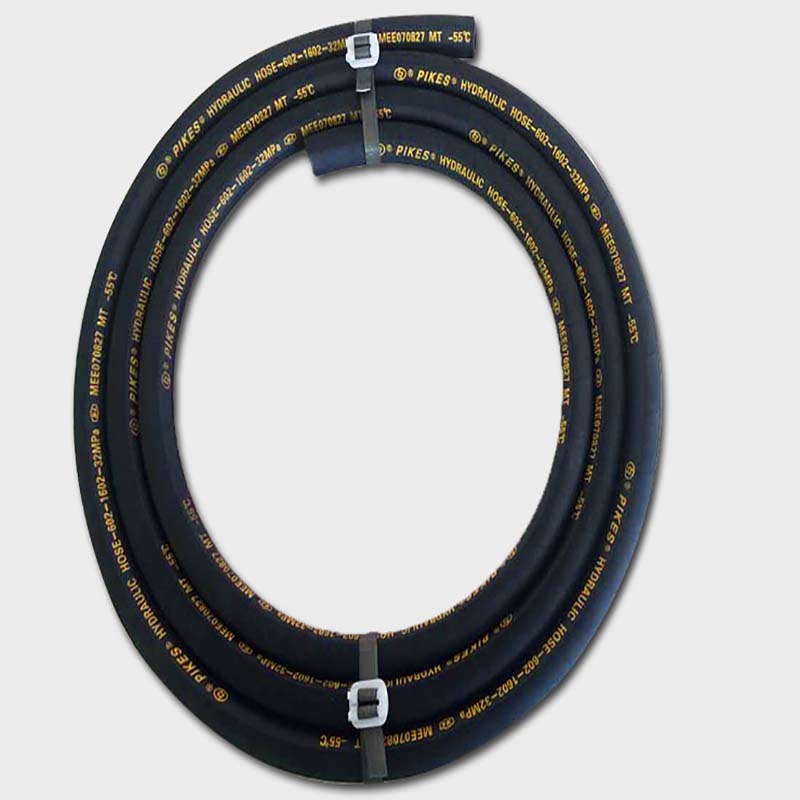
Steel wire skeleton rubber hose hydraulic oil delivery
In hydraulic oil transportation, the use of high-performance hoses is essential. Steel wire skeleton rubber hoses have become an important component of hydraulic systems due to their excellent high temperature resistance, oil resistance, and pressure bearing capacity. So, what are the structural characteristics, material selection, working principle, and application fields of steel wire skeleton rubber hoses? This article will provide you with detailed answers to these questions.
1、 Definition and structure of steel wire skeleton rubber hose
Steel wire skeleton rubber hose is a composite hose made by weaving high-strength steel wire into a skeleton and adding inner and outer layers of rubber. This structural design ensures the strength and toughness of the hose in working condition. Generally speaking, the weaving method of steel wire can be divided into single-layer and multi-layer. The more layers woven, the stronger its pressure bearing capacity and wear resistance.
Among them, the internal rubber layer is mostly made of high-quality synthetic rubber, such as NBR (nitrile rubber) or CR (chloroprene rubber), which have good oil and temperature resistance properties. The outer layer of rubber is usually a weather resistant material that can resist environmental influences such as ultraviolet radiation and ozone.
2、 Analysis of High Temperature and Oil Resistance Performance
High temperature resistance is a major highlight of steel wire skeleton rubber hoses. Rubber materials will soften and degrade at high temperatures, but the special rubber materials used in modern industry generally have a temperature resistance limit of 100 ° C to 150 ° C, and some high-performance varieties can even withstand higher temperatures. This allows this hose to maintain good working performance even in high temperature environments.
Oil resistance is equally crucial. The characteristics of hydraulic oil determine the usage environment of hoses. Improper selection of hose materials may lead to hydraulic oil leakage, hose aging, or failure. Therefore, selecting oil resistant rubber is a prerequisite for ensuring the safe and stable operation of hydraulic systems. NBR material exhibits outstanding resistance to mineral oil, effectively preventing oil penetration and extending the service life of hoses.
3、 Working principle and application field
The working principle of steel wire skeleton rubber hose is based on its structural design. When hydraulic oil is transported through hoses, the inner rubber material bears the enormous pressure brought by the hydraulic pressure, while the steel wire skeleton plays a role in strengthening and supporting. The steel wire braided layer can effectively disperse internal pressure, prevent deformation of the rubber layer, and ensure the stability and safety of the hose in high flow rate and high pressure environments.
This type of hose is widely used in multiple industries, such as:
1. Mechanical manufacturing: used for hydraulic oil transportation of various hydraulic equipment, robotic arms, etc.
2. Automotive industry: mostly used in automotive hydraulic systems, steering systems, and braking systems.
3. Construction engineering: an essential component of equipment such as hydraulic excavators and loaders.
4. Agricultural machinery: such as the oil connections of agricultural tractors.
4、 Selection and Maintenance Guide
When choosing a steel wire skeleton rubber hose, the following factors should be considered:
1. Work pressure: Choose hoses that can withstand pressures higher than the actual usage pressure to ensure safety.
2. Temperature conditions: Select the appropriate type of hose based on the actual temperature of the usage environment.
3. Oil type: Different types of hydraulic oil have different requirements for hose materials, and matching rubber materials need to be selected.
4. Size specifications: Select the appropriate inner and outer diameters according to the usage requirements of the pipeline.
In terms of maintenance, it is crucial to regularly check the wear of hoses and replace aging components in a timely manner. During use, avoid severe impact on the hose and be careful not to expose it to sunlight for too long to prevent the outer rubber from deteriorating.
5、 Summary
The application of steel wire skeleton rubber hoses in hydraulic oil transportation not only solves many shortcomings of traditional hoses, but also becomes one of the essential equipment in various industries due to its excellent high temperature resistance, oil resistance, and toughness. By understanding its structure, performance, and maintenance techniques, the service life of the hose can be effectively extended, ensuring the safe and stable operation of the hydraulic system.
Choosing the appropriate steel wire skeleton rubber hose can not only improve work efficiency, but also reduce operating costs. Against the backdrop of rapid development in modern industry, this high-performance hose will undoubtedly play an important role in an increasing number of fields.